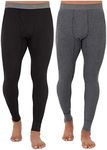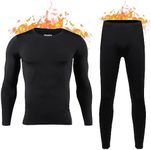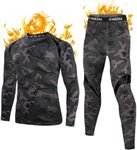Buying Guide for the Best Thermals For Winter
When it comes to staying warm during the winter, choosing the right thermals is crucial. Thermals, also known as base layers, are designed to keep you warm by trapping your body heat and wicking away moisture. The right thermals can make a significant difference in your comfort level during cold weather. Here are some key specifications to consider when selecting thermals for winter.MaterialThe material of thermals is important because it affects warmth, comfort, and moisture-wicking ability. Common materials include wool, synthetic fibers, and cotton. Wool, especially merino wool, is excellent for warmth and moisture-wicking but can be more expensive. Synthetic fibers like polyester are good for moisture-wicking and are often more affordable, but they may not be as warm as wool. Cotton is comfortable but not ideal for moisture-wicking, making it less suitable for intense activities. Choose wool for maximum warmth and moisture control, synthetics for a balance of performance and cost, and cotton for casual, low-activity use.
WeightThermal weight refers to the thickness and warmth of the fabric. Lightweight thermals are suitable for mild cold and high-activity levels, as they provide some warmth without causing overheating. Midweight thermals offer a balance of warmth and breathability, making them versatile for various activities and temperatures. Heavyweight thermals provide maximum warmth and are best for extremely cold conditions or low-activity levels. Select lightweight for mild conditions or high activity, midweight for moderate cold and versatile use, and heavyweight for extreme cold or low activity.
FitThe fit of thermals is crucial for comfort and effectiveness. A snug fit ensures that the thermals can trap body heat and wick away moisture efficiently. However, they should not be too tight, as this can restrict movement and cause discomfort. Loose-fitting thermals may not provide adequate warmth or moisture control. Look for a fit that is close to the body but allows for a full range of motion. Consider your activity level and personal comfort preferences when choosing the fit.
Moisture-WickingMoisture-wicking is the ability of the fabric to draw sweat away from your skin, keeping you dry and comfortable. This is important because wet skin can lead to chills and discomfort in cold weather. Wool and synthetic materials generally have good moisture-wicking properties, while cotton does not. If you plan to engage in physical activities or will be wearing the thermals for extended periods, prioritize moisture-wicking materials to stay dry and warm.
Layering CompatibilityLayering compatibility refers to how well the thermals work with other layers of clothing. Thermals should be thin enough to fit comfortably under your outer layers without causing bulkiness. They should also be able to move with your body and not bunch up. Consider the type of outerwear you will be using and ensure that the thermals can be easily layered underneath. This is especially important for activities like skiing or hiking, where multiple layers are necessary.
DurabilityDurability is important because thermals are often subjected to frequent washing and wear. Look for materials and construction that can withstand regular use without losing their shape or effectiveness. Wool and high-quality synthetic fibers tend to be more durable than cheaper materials. Check for reinforced seams and quality stitching, which can extend the lifespan of your thermals. If you plan to use them frequently or for intense activities, prioritize durability to ensure they last through the season.
























